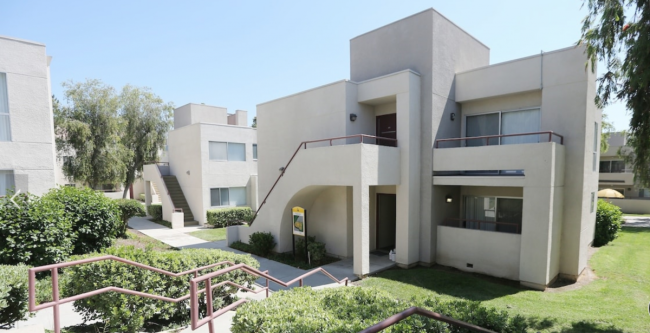You have /5 articles left.
Sign up for a free account or log in.

Cal State L.A. residence hall
Cal State Los Angeles
As many college and university dormitories shut down for the winter break, which often lasts for a month or more, some students have nowhere to go.
They might be estranged from their parents and unable to live at home. They might be newly out of the foster system. Sometimes they have children of their own. Often they’re unable to pay the bills, including groceries.
Historically, many colleges have barred students from dormitories during this time, even if they signed up to use a room the entire academic year.
It’s an issue that housing and student affairs professionals have become acutely aware of over the last several years.
Programs to help students pay for housing during the winter months (and to feed them) have become much more common. Residence halls sometimes do remain open, but sometimes at a cost to their occupants. And administrators still struggle to identify students who are homeless. Students often need to seek out the campus resources, leaving a portion of them to flounder if they are unaware of these programs or embarrassed about a perceived stigma around homelessness.
“It is becoming more evident that our students have become more self-aware of those things and are willing to have conversations around them,” said Von Stange, president-elect of the Association of College and University Housing Officers-International and assistant vice president for student life and senior director of housing and dining at the University of Iowa.
“It’s the same thing if you have a mental health issue no one knew about. Today’s students are more willing to talk about it, see a counselor. I think the culture allows for more openness to help care for more of these students.”
While the campaigns on each campus are going to vary widely, the National Association for the Education of Homeless Children and Youth (NAEHCY) has identified two models on homelessness that it has urged institutions to consider, said Steven Neier, chairman of its higher education committee.
One is the cohort model, used notably at Florida State University, where its Center for Academic Retention and Enhancement picks out low-income, first-generation or homeless students sometimes even before they arrive on campus and then continually monitors them through their time there. The institution will work with local school districts to identify these students, as more often in a K-12 setting the administrators will know if a student is homeless, Neier said. When a student would need housing for a winter break, the university would already be able to identify who needed it.
The other model is called a “service” model. West Chester University, in the suburbs of Philadelphia, sponsors the Promise Program, which pays for homeless students’ housing not only in the winter, but year-round. One student who had grown up bouncing around among friends and relatives told NPR that when after she took advantage of the service, it was the first time she never had to worry about feeling unsafe because someone might “rape or hurt her.”
Neier also said that Kennesaw State University, in Georgia, has created a particularly robust program.
The dormitories stay open year-round at Kennesaw except for two or so weeks in the summer right before the fall semester starts, when they close for cleaning, said Carrie Olsen, program coordinator for the university’s Campus Awareness, Resource and Empowerment, or CARE, services, the center for students who are homeless or struggling to pay for food.
When Kennesaw students pay for housing, the cost of staying over winter break is built in, and they can remain there except for those two weeks in the summer, which do present a problem, Olsen said. If students do need housing over winter break in a pinch, though, the institution has four “emergency” apartments set up. Two are located on its Kennesaw campus, and the other two are at its Marietta location.
The bigger issue comes when dining halls close for the winter, Olsen said. Students who are homeless often depend on their meal plans, she said. CARE offers a large food pantry where students can come once a month (or more frequently if approved by a case manager) to shop in a style similar to a traditional grocery store, Olsen said. They can pick out one jar of peanut butter or a jar of jelly, or select which soups they like, a rarity given that most students don’t get much choice when they’re homeless or “food insecure,” as many industry experts call it, Olsen said.
She noted that the university apartments, and those off-campus, can run from $800 to $900 monthly, which Olsen said is expensive even for working professionals. In fiscal year 2018, CARE’s budget was nearly $59,000 to subsidize housing, as well as for certain scholarships and to fund the pantry. The program is almost entirely funded by donations, except for Olsen’s salary and her director’s, Olsen said.
Financial aid doesn’t cover even close to all the students’ expenses, she said.
“I think my generation and older generations think that’s what financial aid is for,” Olsen said. “They don’t realize there’s such a gap now between what is offered. I go back to when you just paid for your room and board at the beginning of the semester and that was it, but that’s not how things function anymore.”
At Iowa, Stange’s institution, the dormitories also are open during winter, but students generally have to pay $300 or so for the several weeks of break if they plan to be there, he said. The university will waive the fee for low-income students, Stange said.
Iowa is relatively lucky, though. The state’s flagship campus can afford to let certain students not pay. University housing is an auxiliary service with its own budget separate from the general university operating budget, and its dollars come entirely from students paying for housing and the summer conferences the institution hosts, Stange said.
At other, smaller institutions, the decision to remain open could be more difficult, especially if housing is tied to a general operating budget, Stange said.
California State University, Los Angeles, for instance, which serves a high population of Latinx and impoverished students, decided this academic year for the first time to charge students for living on campus during the winter break. The university had alerted students to the new charges, $1,115 for the entire break, in December 2017, but some said they had missed emails and other public notices, said spokesman Robert Lopez. After a student rally against the cost, the university decided to do away with it this winter to allow more time for students to prepare, Lopez said. He said no decision has been made on whether fees will be charged next year. A survey of students in the entire California State University system found that one in 10 experienced homelessness at least once in the previous year. Fewer than 200 people stayed on the Cal State L.A. campus in the winter, Lopez said.
Finding housing can work in more informal ways, too. NAEHCY has encouraged campaigns at colleges and universities for other students to advertise -- largely just by word of mouth -- when they have a free room or bed over winter break, Neier said.
Institutions have also used surveys to identify homeless students, Neier said, and NAEHCY has advocated for them to use the definition of homelessness in the McKinney-Vento Homeless Assistance Act, which is slightly broader than what most students would consider homeless, he said.
McKinney-Vento states that a student can also be deemed homeless if he or she doesn’t have a regular sleeping arrangement, so couch surfing would also count. For university administrators, using the McKinney-Vento definition is helpful because students are often unsure if they fit a definition of homeless, Neier said.
Ideally, campuses would also designate a single person to handle the homeless student population -- if colleges delegated these duties to one official, they could form networks and be more effective statewide, he said. This would be similar to how the McKinney-Vento act requires local K-12 school districts to have a liaison for homeless students. California passed a bill in 2016 that forces most state institutions to designate such a liaison for colleges.
“If higher education were to push for this single-point-of-contact model, this would help raise awareness,” Neier said. “They could be champions of their cause on their campuses.”




